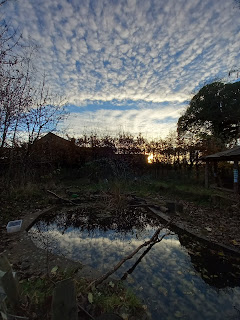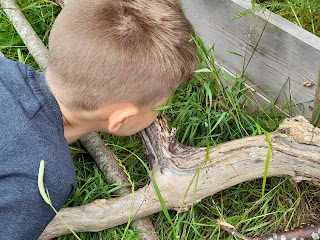Bridge the Gap
The looming date for school opening up to all pupils is being discussed more and more (the date varies across the UK).
For many Forest Schools this signals their opportunity to start running sessions again. There are so many ways Forest Schools deliver time outside that there has been a huge range of effects the pandemic has had on this provision.
Independent Forest Schools have often fallen under the heading of a 'leisure' provider and have struggled to be recognised as a form of education. Some of these small businesses have been closed for almost a year.
Forest School Leaders who have contracts with schools have been on furlough, or just on hold, and unable to provide sessions at all during Lockdown.
Some of us have sites on school grounds and have never closed.
With March 8 growing closer, English FSL are getting ready to see what this means for the Forest School they provide. What is their place within the 'recovery curriculum' that will follow.
Schools had started a 'recovery curriculum' before this latest Lockdown started last month. There has been a focus on covering core aspects missed because of Lockdown 1, and monitoring any areas that may need revisiting. I hate the phrase 'lost learning' as it makes it sound as if it can never be found, as if learning is not a life long process, but there will be gaps where lessons were not delivered as planned - or perhaps at all.
We all know there will be a huge variation within schools, children
who have done all the online learning they could, and then some more, and those who accessed very little. Before learning can take place children heading back to full time school will need to adjust, and settle in, and 'make up for' months of being indoors with most social interactions having been via a screen.
We know stress hampers schooling, and the entire nation has been under stress for almost 12 months, children are not oblivious or immune to this.
'There is no learning without wellbeing' seems more apt than ever.
Wellbeing requires quite a few factors to thrive, one of which has long since been linked with simply going outside. Yes the playground helps, but what are needed are green spaces.
The natural environment has been shown to have a positive effect on the part of the brain that processes emotion (the amygdala), spending just 20 minutes outdoors significantly lowers stress hormones present in saliva, and the microbiomes in woodland and green spaces help the good microbiomes inside of us.
Being outside makes us mentally and physically stronger.
Time amongst trees and grass can create benefits, even if it's only temporary bursts, but for ongoing wellbeing there needs to be a relationship with the outdoors. It's why Forest School aim for regular and long term sessions, stretching across seasons, allowing the changes to be observed, allowing the time to find what you need from nature, the opportunity to connect with nature.
Forming a connection with nature is good for humans and good for nature! The two are pretty much one and the same! We understand that whales need the oceans, fish need the rivers, birds need the trees and sky... but we question what we as people NEED from nature. We are as much a part of it as any other living thing.
There is no human wellbeing without nature's wellbeing. If we want children to embrace the planet they live on, to make it habitable for all, we need them to spend time within it for their wellbeing, and time building a relationship with it so they care about it. I'd like to think that Forest School attempts to forge that partnership. That the space, the exploration, and the opportunity to follow their own interests, makes them feel good, exercises their minds and bodies, and ignites their curiosity.
If we want a true link, one that makes our children's future less vulnerable, their lives more fulfilling, and their self esteem strong, we need to make it a two-way thing and allow nature to spill into classrooms.
Children need to understand their place within nature and the environment on a wider scale, as well as actual exploration in woodland and grass.
In the classroom it can be making data handling about birdwatching stats, or a biodiversity search, or categorising lichen around the school.
It can be designing bird boxes and hedgehog homes and giant bug hotels.
It can be bark rubbing and art in situ, weather stations and giant compasses...
It can link what is outside the window to whatever the curriculum demands. It can form links between the practical and the theory, and make global issues such as extinction, climate change, recycling etc, local and real to the children.
Daily weather reports, season acknowledgements, Midsummer Day being celebrated, every class growing plants and food, visits to and from nature, etc. are not difficult to slide into a school timetable.
A connection with nature is the start to conservation of nature, so the knowledge and relationship we foster now may directly impact their future. Let's not pretend that pupils today aren't going to face forging a life and a living in a world where pollution and global warming are bigger issues than they are now. 'Renewable' and 'sustainable' industries and production are growing areas of employment and research. The disconnect from the natural world has slowly increased over the last decades, we need to bridge that gap and start a 21st century relationship with the world around us that will benefit generations to come.
Feeling that life, all life, has meaning, and that we have a place within the environment in which we live has a positive effect on mental health. Knowing we can make worthwhile contributions to the world around us has a positive effect on self esteem. Actually doing this and seeing the results unfold has a positive effect on confidence.
Good mental health, positive self esteem, and confidence add up to a reasonable satisfaction in life in general, and makes all of us more receptive to learning.
So let's use nature learning, Forest School, wildlife connection, gardening, etc indoors AND outdoors together to support children's learning as we move forward into a post lockdown curriculum.













Comments
Post a Comment